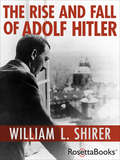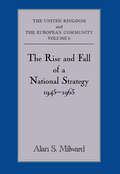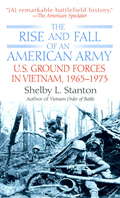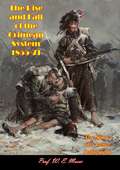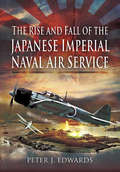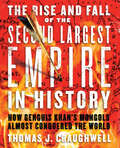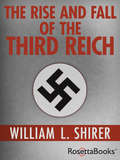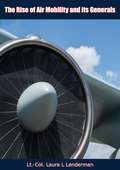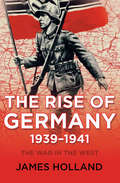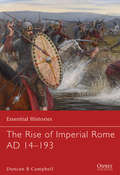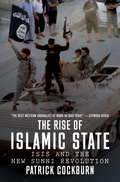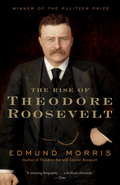- Table View
- List View
The Rise Of Wellington
by Field-Marshal Lord Roberts Of Kandahar V.C.In this short but eminently concentrated biography, Field-Marshal "Bobs" Roberts V.C., who was among the best loved of all British commanding officers reviews the military achievements of one of the most successful British generals, the Duke of Wellington. Eschewing any attempt to cover the Duke's later life in politics or his private life; Lord Roberts focusses on the Duke of Wellington's rise from lowly rank to Napoleon's nemesis at Waterloo. As the author himself begins his book;"THE military career of Wellington naturally divides itself into three periods--the Indian period, the Peninsular period, and the period during which he commanded the Allied Forces in the Netherlands, terminating in the battle of Waterloo. I propose, therefore, in three chapters, relating in turn to each of these periods, briefly to describe the principal incidents of this great soldier's life, and to show how the experience he gained first in the East, and afterwards in South-Western Europe, so developed his natural talents and administrative capacity that he was finally able to meet and overthrow the French Emperor, whose genius for war had up to that date been regarded as absolutely unrivalled."
The Rise and Fall of Adolf Hitler: The Rise And Fall Of Adolf Hitler
by William L. ShirerA concise and timely account of Hitler&’s—and fascism&’s—rise to power and ultimate defeat, from one of America&’s most famous journalists. American journalist and author William L. Shirer was a correspondent for six years in Nazi Germany—and had a front-row seat to Hitler&’s mounting influence. His most definitive work on the subject, The Rise and Fall of the Third Reich, is a riveting account defined by first-person experience interviewing Hitler, watching his impassioned speeches, and living in a country transformed by war and dictatorship. Shirer was originally commissioned to write The Rise and Fall of Adolf Hitler for a young adult audience. This account loses none of the immediacy of The Rise and Fall of the Third Reich—capturing Hitler&’s ascendence from obscurity, the horror of Nazi Germany&’s mass killings, and the paranoia and insanity that marked the führer&’s downfall. This book is by no means simplified—and is sure to appeal to adults as well as young people with an interest in World War II history. &“For nearly 100 years William L Shirer has spoken to us of fascism, Nazis, and Hitler . . . [He] tells the unvarnished truth as he experienced it . . . I figured this school-type book wasn&’t going to tell me anything new. But when I started reading, I realized that I wasn&’t reading for the facts anymore. I listened to his story and heard the urgency in his voice: a voice from nearly 60 years ago telling us the truth about today.&” —Daily Kos
The Rise and Fall of British Crusader Medievalism, c.1825–1945 (Advances in Crusades Research)
by Mike HorswellThis book investigates the uses of crusader medievalism – the memory of the crusades and crusading rhetoric and imagery – in Britain, from Walter Scott’s The Talisman (1825) to the end of the Second World War. It seeks to understand why and when the crusades and crusading were popular, how they fitted with other cultural trends of the Victorian and Edwardian eras, how their use was affected by the turmoil of the First World War and whether they were differently employed in the interwar years and in the 1939-45 conflict. Building on existing studies and contributing the fruits of fresh research, it brings together examples of the uses of the crusades from disparate contexts and integrates them into the story of the rise and fall crusader medievalism in Britain.
The Rise and Fall of Comradeship: Hitler's Soldiers, Male Bonding and Mass Violence in the Twentieth Century
by Thomas KühneThis is an innovative account of how the concept of comradeship shaped the actions, emotions and ideas of ordinary German soldiers across the two world wars and during the Holocaust. Using individual soldiers' diaries, personal letters and memoirs, Kühne reveals the ways in which soldiers' longing for community, and the practice of male bonding and togetherness, sustained the Third Reich's pursuit of war and genocide. Comradeship fuelled the soldiers' fighting morale. It also propelled these soldiers forward into war crimes and acts of mass murders. Yet, by practising comradeship, the soldiers could maintain the myth that they were morally sacrosanct. Post-1945, the notion of kameradschaft as the epitome of humane and egalitarian solidarity allowed Hitler's soldiers to join the euphoria for peace and democracy in the Federal Republic, finally shaping popular memories of the war through the end of the twentieth century. Offers a cultural approach to military history, demonstrating the way in which ordinary soldiers thought, felt, made choices and coped with mass death and violence. Explores the multifaceted fabric of male bonding and how 'hard' and 'soft' features work together. Explains some of the discontinuities in Germany's twentieth century and how those engaged in brutal genocidal violence could then form one of the strongest democracies ever to be established.
The Rise and Fall of War Crimes Trials
by Charles Anthony SmithThis book is the first comprehensive analysis of the politics of war crimes trials. It provides a systematic and theoretically rigorous examination of whether these trials are used as tools for political consolidation or whether justice is their primary purpose. The consideration of cases begins with the trial of Charles I of England and goes through the presidency of George W. Bush, including the trials of Saddam Hussein and those arising from the War on Terror. The book concludes that political consolidation is the primary concern of these trials - a point that runs contrary to the popular perception of the trials and their stated justification. Through the consideration of war crimes trials, this book makes a contribution to our understanding of power and conflict resolution and illuminates the developmental path of war crimes tribunals.
The Rise and Fall of a National Strategy: The UK and The European Community: Volume 1 (Government Official History Series #Vol. 1)
by Alan S. MilwardThis text analyzes British official thinking behind the UK's standing aloof from the moves after 1945 towards European economic collaboration, leading to the establishment of ECSC and the EEC in the 1950s. It deals with the later change of tack (1961), covers the organization in Whitehall for the negotiations with the Communities, and the major problem areas - the Commonwealth, British agriculture, financial implications of British membership, sovereignty, and the future of EFTA.
The Rise and Fall of an American Army
by Shelby L. Stanton“THE MEN WHO SACRIFICED FOR THEIR COUNTRY ARE RIGHTFULLY HERALDED . . . This is an honest book–one well worth reading. . . . Stanton has laid his claim to the historian’s ranks by providing his reader with well-documented, interpretive assessments. ” –Parameters The Vietnam War remains deep in the nation’s consciousness. It is vital that we know exactly what happened there–and who made it happen. This book provides a complete account of American Army ground combat forces–who they were, how they got to the battlefield, and what they did there. Year by year, battlefield by battlefield, the narrative follows the war in extraordinary, gripping detail. Over the course of the decade, the changes in fighting and in the combat troops themselves are described and documented. The Rise and Fall of an American Armyrepresents the first total battlefield history of Army ground forces in the Vietnam War, containing much previously unreleased archival material. It re-creates the feel of battle with dramatic precision. “Stanton’s writing . . . gives the reader a terrifying graphic description of combat in the many mini-environments of Vietnam. ” –TheNew York Times “[A] MOVING, IMPORTANT BOOK. ” –St. Louis Post-Dispatch
The Rise and Fall of the Crimean System 1855-71: The Story of a Peace Settlement
by Prof. W. E. MosseThe Crimean war and the settlement by which it was concluded formed the climax of then-British Prime Minister Palmerston's later diplomacy. In Palmerston's view, much like the war itself, the peace settlement that followed was intended to "to curb the aggressive ambition of Russia. We went to war not so much to keep the Sultan and his Mussulmans in Turkey as to keep the Russians out of Turkey."Apart from material guarantees like the neutralization of the Black Sea and the removal of Russia from all contact with the navigable portion of the Danube and its tributaries, Palmerston sought to achieve his object above all by a policy of diplomatic 'containment,' to construct 'a long line of circumvallation to confine the future extension of Russia,' and thus ultimately prevent any potential future conflict.This book, originally published in 1963, thoroughly examines Crimean system, from its inception and rise, through to the initial signing of the Triple Treaty on 15 April 1856, its subsequent testing time, and the eventual demise of the Crimean system.The detailed study seeks to provide the reader with some answers to the general questions that arise with the implementation of international engagements, such as:"What is the value of a unilaterally imposed peace settlement? Do treaties of guarantee serve any useful purpose? What, in general, is the relationship between original intent at the signing of a treaty and the policy or will of the given moment? Will any government, in fulfilment of treaty obligations, pursue a line of policy to which it is not otherwise inclined? Will a government in pursuance of obligations contracted years before, act in opposition to the 'national interest' of the moment? In short, is there such a thing as the much proclaimed 'faith of treaties'?"
The Rise and Fall of the Healthy Factory
by Vicky LongThe first account of the emergence and demise of preventive health care for workers. It explores how trade unions, employers, doctors and the government reconfigured the relationship between health, productivity and the factory over the course of the twentieth century within a broader political, industrial and social context.
The Rise and Fall of the Japanese Imperial Naval Air Service
by Peter J. EdwardsThis book describes in considerable detail the people, events ships and aircraft that shaped the Air Service from its origins in the late 19th century to its demise in 1945. The formative years began when a British Naval Mission was established in Japan in 1867 to advise on the development of balloons for naval purposes. After the first successful flights of fixed-wing aircraft in the USA and Europe, the Japanese navy sent several officers to train in Europe as pilots and imported a steady stream of new models to evaluate.During World War One Japan became allied with the UK and played a significant part in keeping the German fleets of ships and submarines at bay in the Pacific and Indian Oceans. However, in the international naval treaties that followed they felt betrayed, since the number of capital ships, battleships and cruisers, that they were allowed was below those of the USA and the UK.Aircraft carriers were not included, so a program of carrier building was started and continued until World War Two. At the same time they developed an aircraft industry and at the beginning of war their airplanes were comparable, and in some instances superior, to those of the British and Americans.Much prewar experience was gained during Japans invasion of China, but their continued anger with America festered and resulted in their becoming allied with Germany, Italy and the Vichy France during World War Two. There followed massive successful attacks on Pearl Harbor, the Philippines, the Southern Islands, Port Darwin and New Guinea.The British were decimated and the USA recoiled at the onslaught, taking over a year to regroup and take the war to the Imperial Japanese forces. Throughout the conflict many sea battles were fought and the name Zero became legendary. When Japan eventually capitulated after the Atomic bombs were dropped the Japanese Imperial Air Service was disbanded.
The Rise and Fall of the Knights Templar: The Order of the Temple 1118-1314 - A True History of Faith, Glory, Betrayal
by Gordon NapierA highly readable look at the lifespan of the famous Knights Templar, who were warrior monks and the first disciplined, regulated, and uniformed standing army since antiquity throughout Europe and the Holy Lands—an economic force to be reckoned with and perhaps an institution guarding dark secrets. The origins of the concept of Holy War are explored, from Biblical times through the rise of Islam and the Christian movement, which inspired untold thousands to set out to recapture Jerusalem, as warriors and as pilgrims. This book explains how nine knights led by Hugues de Payens came from France to guard pilgrims in the Holy Land, how they gained the site of the Temple of Solomon, and what they did there, including a reevaluation of the historical evidence. Other topics discussed include how an unprecedented religious Order grew and pledged to bloodshed in defense of pilgrims, the territory conquered by the Crusaders, and the role and agenda of Saint Bernard of Clairvaux and other powerful backers. The Order's contribution to the ongoing Crusades is explained, as well as their military tactics and organization and the fortresses and bases they established. Discussion of the fate of the Order after the failure of the Crusades includes a detailed examination of the charges of occult rituals involving idol worship, spitting on the Cross, and obscene kisses, through to the burning of the last Grand Master Jacques de Molay in 1314.
The Rise and Fall of the Second Largest Empire in History: How Genghis Khan's Mongols Almost Conquered the World
by Thomas J. CraughwellHow Genghis Khan and the Mongols conquered nearly one-sixth of the planet: “The fascinating story of history’s most misunderstood empire builders.” —Alan Axelrod, bestselling author of Miracle at Belleau WoodEmerging out of the vast steppes of Central Asia in the early 1200s, the Mongols, under their ferocious leader, Genghis Khan, quickly carved out an empire that by the late thirteenth century covered almost one-sixth of the Earth’s landmass—from Eastern Europe to the eastern shore of Asia—and encompassed 110 million people. Far larger than the much more famous domains of Alexander the Great and ancient Rome, it has since been surpassed in overall size and reach only by the British Empire.The Rise and Fall of the Second Largest Empire in the World recounts the spectacularly rapid expansion and dramatic decline of the Mongol realm, while examining its real, widespread, and enduring influence on countless communities from the Danube River to the Pacific Ocean.“Great sweeping history from a superb writer.” —Joseph Cummins, author of The War Chronicles“A skillful and imaginative storyteller and conscientious historian.” —David Willis McCullough, author of Wars of the Irish Kings
The Rise and Fall of the Soviet Navy in the Baltic 1921-1941
by Gunnar ÅseliusThis book, based on extensive work in Russian archives, investigates how strategy, organisational rivalry and cultural factors came to shape naval developments in the Soviet Union, up to the invasion of 1941. Focussing on the Baltic Fleet, the author shows how the perceived balance of power in northern Europe came to have a major influence on Sovie
The Rise and Fall of the Third Reich: A History Of Nazi Germany
by William L. ShirerNational Book Award Winner: The definitive account of Nazi Germany and &“one of the most important works of history of our time&” (The New York Times). When the Third Reich fell, it fell swiftly. The Nazis had little time to destroy their memos, their letters, or their diaries. William L. Shirer&’s sweeping account of the Third Reich uses these unique sources, combined with his experience living in Germany as an international correspondent throughout the war. The Rise and Fall of the Third Reich earned Shirer a National Book Award and continues to be recognized as one of the most important and authoritative books about the Third Reich and Nazi Germany ever written. The diaries of propaganda minister Joseph Goebbels, as well as evidence and other testimony gained at the Nuremberg Trials, could not have found more artful hands. Shirer gives a clear, detailed, and well-documented account of how it was that Adolf Hitler almost succeeded in conquering the world. With millions of copies in print, The Rise and Fall of the Third Reich is a chilling and illuminating portrait of mankind&’s darkest hours. &“A monumental work.&” —Theodore H. White
The Rise and Fall of the Third Reich: A History of Nazi Germany
by William L. ShirerBefore the Nazies could destroy the files, famed foreign correspondent and historian William L. Shirer sifted through the massive self-documentation of the Third Reich, to create a monumental study that has been widely acclaimed as the definitive record of one of the most frightening chapters in the history of mankind--now in a special 30th anniversary edition.<P><P> Winner of the National Book Award
The Rise of Air Mobility and its Generals
by Lt.-Col. Laura L. LendermanIn the early years of the Cold War, the United States relied on strategic nuclear attack as the primary means of deterring the Soviet Union. The focus on manned bombers and atomic weapons led to the rise of Strategic Air Command and its leaders, the bomber generals, within the Air Force. The power and influence of the bomber generals peaked in the early 1960s. In the following two decades, Tactical Air Command and the power of fighter generals rose within the Air Force. Mike Worden described this transformation of leadership in his insightful book "Rise of the Fighter Generals: The Problem of Air Force Leadership, 1945-1982." Worden argued that fighter pilots rose to pre-eminence over bomber pilots because the bomber generals failed to adjust to changing realities related to America's failure in Vietnam and a growing conventional Soviet threat. The transition was complete by 1982, when a fighter pilot, Gen Charles A. Gabriel, became Air Force chief of staff. Today, 25 years after first assuming top command, fighter pilots continue to lead the Air Force.
The Rise of China
by Michael E. Brown Owen R. Coté Sean M. Lynn-Jones Steven E. MillerChina's relentless economic growth in the 1980s and 1990s heralded its emergence as a great power in world politics. As its economy expanded, China seemed poised to become the second-largest economy in the world. At the same time, it modernized its military and adopted a more assertive diplomatic posture. Many observers have begun to debate the international implications of China's rise. Some analysts argue that China will inevitably pose a threat to peace and security in East Asia. A few even predict a new cold war between Beijing and Washington. Others claim that a powerful China can remain benign. None believes that China can be ignored. The essays in this volume assess China's emerging capabilities and intentions, debate the impact that China will have on security in the Asia-Pacific region, and propose polices for the United States to adopt in its relations with China.
The Rise of China and International Security: America and Asia Respond (Asian Security Studies)
by Yoichiro Sato Kevin J. CooneyThis edited volume offers diverse and comprehensive views of China's rise and its implications to the East Asian region and beyond. The economic growth of China, initially started in the late-1970s with domestic and rural reforms, has been increasingly driven by China's industrialization and integration into the regional and global markets. The gro
The Rise of Germany, 1939–1941: The War in the West (The\war In The West Ser.)
by James HollandAn account of the early years of World War II based on extensive new research: &“A genuinely fresh approach . . . exceptional&” (The Wall Street Journal). James Holland, one of the leading young historians of World War II, has spent over a decade conducting new research, interviewing survivors, and exploring archives that have never before been so accessible to unearth forgotten memoirs, letters, and official records. In The Rise of Germany 1938–1941, Holland draws on this research to reconsider the strategy, tactics, and economic, political, and social aspects of the war. The Rise of Germany is a masterful book that redefines our understanding of the opening years of World War II. Beginning with the lead-up to the outbreak of war in 1939 and ending in the middle of 1941 on the eve of Operation Barbarossa, the Nazi invasion of Russia, this book is a landmark history of the war on land, in the air, and at sea. &“Magnificent.&” —Andrew Roberts, New York Times–bestselling author of The Storm of War
The Rise of Hitler: Rare Photographs From Wartime Archives (Images of War)
by Trevor SalisburyIn 1945, amidst the ruins of a bomb-damaged German home a tattered book, Deutschland Erwache, was recovered as a souvenir by a British soldier. This rare and invaluable primary resource now forms the basis of The Rise of Hitler Illustrated, which is a photographic record of Hitlers' rise to power from when he was born in 1889, as he took over the hearts and minds of the German people, and his eventual arrival at the top.The original book is typical of the propaganda of the time, with the obvious non-critical acceptance of everything that Adolf Hitler was and what he stood for. It attempts to present him as a peaceloving man, who wanted nothing other than quiet in his 'beloved Alps', who dearly loved children and was kind to all. But as we all know, the truth was completely different. He was a man who, despite his unbounded evilness, was able to assert limitless power over a nation before creating maximum misery for millions.When found, the original book was divest of its cover and all the worse for wear, but Trevor Salisbury has gone to every effort to salvage some of the images, the result a fresh and new perspective that sheds light on Hitler's control of Germany. It is a welcome addition to Pen & Sword's highly acclaimed Images of War series.
The Rise of Imperial Rome AD 14-193
by Duncan CampbellWhen Augustus (r. 27 BC-AD 14) came to the throne as the first emperor of Rome, he began to bring order to the chaos that almost 20 years of civil war had wrought. Areas that had been added piecemeal to the Roman Republic, from Spain and Gaul to Dalmatia, needed to be restructured as provinces of the empire, while in the East, Augustus reorganised Asia Minor and Syria, and held the Parthian empire in check with cunning diplomacy. The foundations of the empire were thus laid by Augustus, and his aspirations for world conquest were passed on to his successors, who would strive to defend, expand and consolidate the empire after his death. Under Trajan (AD 98-117) the empire reached its largest extent - some 6.5 million square kilometres. Its presence in much of present-day Western and Central Europe gave the area a lasting legacy in a range of areas, from legal matters to languages and from architecture to religious belief.In this book ancient-warfare specialist Duncan Campbell explores the course of the wars that ensued as successive emperors sought to extend the empire, from Claudius' conquest of Britannia (AD 43) and Domitian's campaigns on the Rhine (AD 83) and the Danube (AD 89, 92), through Trajan's Dacian Wars (AD 101-03, 105-06) and Parthian War (AD 117), to Marcus Aurelius' Marcomannic Wars (AD 167-75, 177-80), as well as the Jewish Wars (AD 66-74 and AD 132-36). The period covered in this book ends with the consolidation of the Roman frontiers along the Rhine and Danube - 'this far and no further' - and uneasy peace with the Parthian empire, wracked by its own internal troubles. The murder of the emperor Pertinax in AD 193 was to usher in a period of instability and civil war, dominated by the mighty Septimius Severus (r. AD 193-212).This book provides a summary of the strengths, limitations and evolving character of the Roman army during the first two centuries AD, as well as those of the forces of Rome's enemies across the Rhine and Danube in Germany and Romania, and in the East, in the form of the Parthian empire of Iraq/Iran. The characters and achievements of the soldiers and civilians who fought Rome's enemies and administered the new provinces carved out in war are brought to life in vivid detail. Fully illustrated with photographs depicting the emperors, their armies and enemies, and the remains of Roman fortifications and public buildings, plus informative full-colour maps, this is the epic story of the wars waged by a succession of emperors during the period in which Imperial Rome reached its zenith.
The Rise of Islamic State
by Patrick CockburnOut of the failures of Iraq and Afghanistan, the Arab Spring and Syria, a new threat emerges. While Al Qaeda is weakened, new jihadi movements, especially ISIS, are starting to emerge. In military operations in June 2014 they were far more successful than Al Qaeda ever were, taking territory that reaches across borders and includes the city of Mosul. The reports of their military coordination and brutality are chilling. While they call for the formation of a new caliphate once again the West becomes a target. How could things have gone so badly wrong? In The Rise of Islamic State, Cockburn analyzes the reasons for the unfolding of US and the West's greatest foreign policy debacle and the impact that it has on the war-torn and volatile Middle East.From the Trade Paperback edition.
The Rise of Modern Communism (Third Edition)
by Massimo SalvadoriThe book is about the communist movement in the twentieth century. Author says that communism is described as the natural and almost inevitable expression of Marxism.
The Rise of Theodore Roosevelt: The Rise Of Theodore Roosevelt, Theodore Rex, And Colonel Roosevelt (Modern Library 100 Best Nonfiction Books)
by Edmund MorrisThis is Morris's highly acclaimed account of Theodore Roosevelt's life, encompassing the years from Roosevelt's birth to his service in the White House. He was one of our most vibrant presidents; his image still haunts our past and our present. This fascinating and comprehensive biography of the extraordinary naturalist, adventurer, soldier, and politician, tells the improbable, but very real, story of a man determined to get what he wanted, an American who helped define our century and our very character.<P><P> Winner of the Publitzer Prize<P> Winner of the National Book Award
The Rise of the G.I. Army, 1940–1941: The Forgotten Story of How America Forged a Powerful Army Before Pearl Harbor
by Paul Dickson“A must-read book that explores a vital pre-war effort [with] deep research and gripping writing.” —Washington TimesIn The rise of the G.I. Army, 1940–1941, Paul Dickson tells the dramatic story of how the American Army was mobilized from scattered outposts two years before Pearl Harbor into the disciplined and mobile fighting force that helped win World War II.In September 1939, when Nazi Germany invaded Poland and initiated World War II, America had strong isolationist leanings. The US Army stood at fewer than 200,000 men—unprepared to defend the country, much less carry the fight to Europe and the Far East. And yet, less than a year after Pearl Harbor, the American army led the Allied invasion of North Africa, beginning the campaign that would defeat Germany, and the Navy and Marines were fully engaged with Japan in the Pacific.Dickson chronicles this transformation from Franklin Roosevelt’s selection of George C. Marshall to be Army Chief of Staff to the remarkable peace-time draft of 1940 and the massive and unprecedented mock battles in Tennessee, Louisiana, and the Carolinas by which the skill and spirit of the Army were forged and out of which iconic leaders like Eisenhower, Bradley, and Clark emerged. The narrative unfolds against a backdrop of political and cultural isolationist resistance and racial tension at home, and the increasingly perceived threat of attack from both Germany and Japan.

